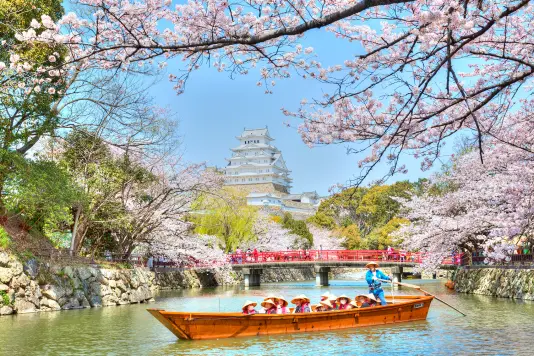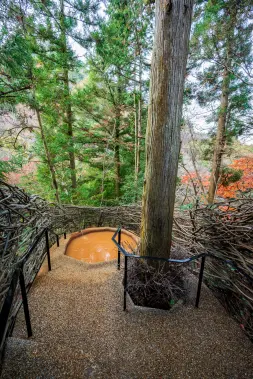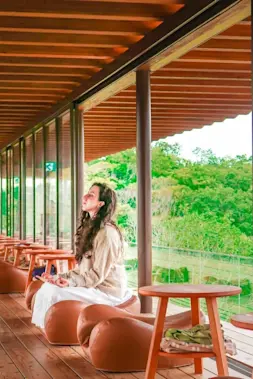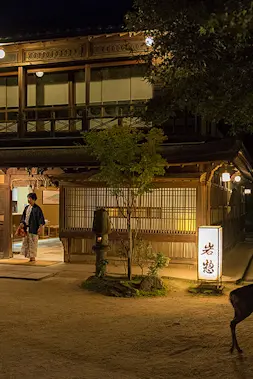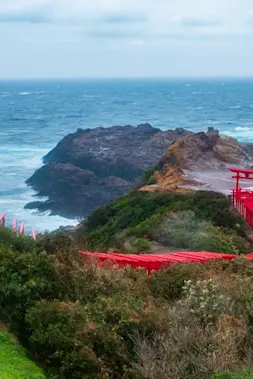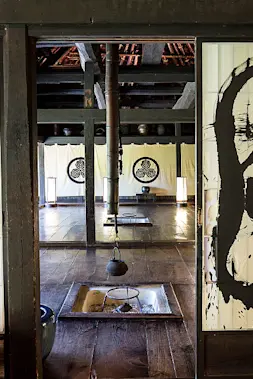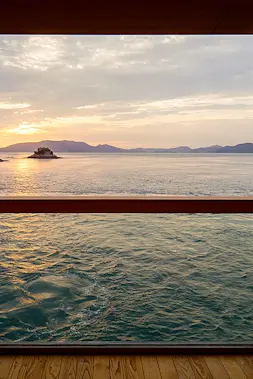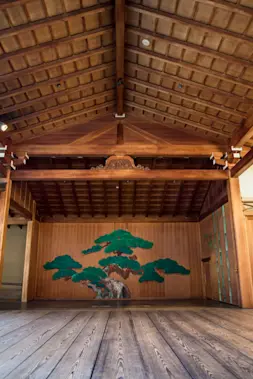Relaxing Stay
Awaji Hamarikyu - Sun, Sea, Sand and Sakura Trout

-
- DESTINATION NAME
- Hyogo
-
- RELATED TAGS
-
- LAST UPDATED
- 16 October, 2019
The Hotel New Awaji Villa Awaji Hamarikyu – or Hamarikyu for short – sits on Awaji Island that connects Osaka and Kobe to Shikoku. With its prime location looking out over the Seto Inland Sea and fronting a beautiful sandy beach, the hotel offers guests a chance to enjoy some of the best views in the region while relaxing in pure luxury.
“This hotel was created with one thing in mind – to ensure the guests can escape the stresses of everyday life and lose themselves in this calm atmosphere,” says Yuki Umano, staff leader at the Hamarikyu. “A lot of our customers keep coming back and some use this hotel instead of owning a holiday home.”
Hamarikyu is one of twenty hotels in the Hotel New Awaji group and opened its doors in 2013 after extensive refurbishment. Although being relatively close to Kobe and Osaka with easy access to both cities, they feel a million miles away as you step onto Hamarikyu’s green lawn and gaze out over the beach and the calm waters beyond.
Hamarikyu prides itself on four things – lavish rooms, a quality hot spring bath, a gorgeous beach, and exceptional cuisine.
The hotel building itself feels exotic with its unique architecture and decor. As soon as you walk in, the building transports you to a different world. The grand entrance with its open staircases, the dining room with its colorful stained glass patterns all add to the experience. You lose yourself in the remarkable ambience that seems to envelop Hamarikyu.
With only 29 rooms in total, Hamarikyu feels like a boutique hotel. The friendly and attentive staff set you at ease and the spacious rooms come with everything you need and more. 13 rooms come fitted with private outdoor rotenburo baths on the balcony.
“Many of our guests spend a lot of time relaxing in their rooms,” says Umano. “During the summer, people use the beach right in front of the hotel. There’s also a pool outside for small children.”
The pristine beach faces west, meaning on clear days you’ll witness unforgettable sunsets over the sea. It lives up to its ranking among the 88 finest sunset locations in Japan. Even on an overcast day, I managed to catch a glimpse of the sun as it set over the horizon.
The natural hot spring water in Hamarikyu is well-renowned. Known as bijin-no-yu or “beautifying waters”, the water texture feels more viscous than normal.
“It almost feels like there’s moisturizer in the water itself,” says Umano. “One dip in the bath will leave your skin feeling smooth as satin for the rest of the day.”
Another big reason guests keep coming back to Hamarikyu is head chef Yuuki Emoto’s sensational cuisine. Aside from each course being planned and prepared to perfection, Emoto provides guests with something you could rarely find anywhere else – every meal made almost exclusively with organic ingredients sourced from Awaji Island.
“We have created a close relationship over five years with three local farmers who provide 80% to 90% of the produce we use in our cooking,” explains Emoto. “We work together and sometimes ask the farmers to experiment growing different vegetables. Like us, all our farmers are very committed to organic farming.”
Emoto visits the farms three times a week. He takes left overs from stock soups and vegetable cuttings back to the farmers to turn into fertilizer and brings back the best seasonal ingredients to serve to his guests.
At Hamarikyu, they offer three main seasonal ingredients that keep people coming back year after year. They serve sakura trout in spring, hamo conger pike in summer, and tora fugu pufferfish in winter – all bred or sourced from inside Awaji Island.
The main ingredient in my dinner course was the sakura trout. Bred and farmed using revised methods and new technologies, the trout was good enough to eat raw.
The meal was a modern kaiseki course with elements of both traditional Japanese and western cuisine, all interlaced with Emoto’s flair and ingenuity. Emoto never overburdened the dishes with excess flavoring or powerful seasoning. He enhanced and drew out the natural flavors of all the ingredients in every dish.
“We try not to add anything extra – for me less is more,” explains Emoto. “For example, after we fillet a fish, we bake the bones in the oven, then simmer them to create a stock to flavor the fish. We try to use everything. We’re blessed in Awaji – there’s so much quality produce inside the island.”
Emoto adapts his cooking to match the seasonal ingredients rather than shaping the ingredients to match his cooking. This means no two meals at Hamarikyu will ever be the same. Just another reason to keep coming back to this beautiful corner of the Seto Inland Sea.
Photographs & Text by Tom Miyagawa Coulton
RELATED DESTINATION
Hyogo
Hyogo Prefecture is roughly in the center of the Japanese archipelago. It has the Port of Kobe, which plays an important role as the gateway of Japan. It also is home to plentiful tourist attractions such as Himeji Castle, a UNESCO World Heritage site, and several hot spring areas. Kobe beef, one of the three major brands of wagyu beef, is a delicacy.
